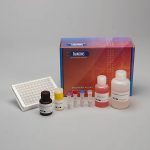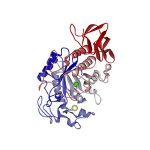
Salimetrics Assay #1-1902
The Salimetrics Salivary Alpha-Amylase Assay Kit is specifically designed to standardize the detection of alpha-amylase in saliva samples for research and biomedical laboratories. α-Amylase has been identified as a biomarker that shows potential to be a surrogate marker of autonomic (sympathetic) nervous system activation. Secretion of α-amylase from the salivary glands is controlled by autonomic nervous signals and a substantial amount of literature reveals that salivary α-amylase is a correlate of sympathetic activity under conditions of stress. Studies show that levels of salivary α-amylase increase under a variety of physically (i.e., exercise, heat and cold) and psychologically (i.e., written examinations) stressful conditions in human subjects. Studies also show that α-amylase levels do not often correlate with cortisol during stress, suggesting that individual differences in α-amylase represent a response to a stress signal independent of the LHPA axis. Read More...Alpha-amylase is also believed to play a key role in the establishment and maintenance of the oral microflora to form dental plaques. Although its release from the salivary cells is greatly increased in response to taste or chewing motions of the jaw, salivary α-amylase levels are not related to α-amylase levels in blood, which are derived from pancreatic secretion. In addition, alpha-amylase is present in low levels in non-stimulated saliva between meals, due to its important anti-bacterial role in the oral cavity.
Using a small sample volume, this direct saliva assay kit has an extended range which spans the expected alpha-amylase levels found in human saliva. The average inter- and intra-assay precision coefficients of variation are low with no deleterious matrix effects often found in saliva which are characterized through dilution- and spike-recovery validation procedures. This alpha-amylase assay kit has also been formatted to minimize cross reactivity for related proteins.
Technical Summary
| Assay Protocol |
|---|
| Rev. 05.30.25
|
| Specifications | |
|---|---|
| Catalog#: | 1-1902 |
| Regulatory Status: | RUO |
| Format: | 96-well plate |
| Assay Time: | ~ 30 mins |
| Sample Volume/Test: | 10 µL of saliva then 8 µL of X200 dilution |
| Sensitivity: | 0.4 U/mL |
| Assay Range: | 2-400 U/mL |
| Storage Requirements: | 2-8°C |
| Tests Per Kit | |
|---|---|
| Singlet: | 94 |
| Duplicate: | 46 |
| Target Analyte |
|---|
| Technical Documentation |
|---|
| Technical Bulletin - Running Multiple Amylase Strips
SDS Available on Request |
Salivary Alpha-Amylase Assay Kit Overview
Intended Use
The Salimetrics Alpha-Amylase Kinetic/Enzymatic Assay Kit is specifically designed and validated for the kinetic measurement of salivary α-amylase activity. It is not intended for diagnostic use. It is intended only for research use in humans and some animals. Salimetrics has not validated this kit for serum or plasma samples.
Introduction
Technical advances that make the assessment of biomarkers in saliva possible have enabled researchers to non-invasively study biosocial processes related to stress in naturalistic contexts. Secretion of alpha-amylase from the salivary glands is controlled by autonomic nervous signals, and substantial literature reveals that salivary alpha-amylase is a correlate of sympathetic activity under conditions of stress. Studies show that levels of salivary alpha-amylase increase under a variety of physically (i.e., exercise, heat and cold) and psychologically (i.e., written examinations) stressful conditions in human subjects. Interestingly, studies show that cortisol levels often do not correlate with α-amylase during stress, suggesting that individual differences in alpha-amylase represent a response to a stress signal independent of the LHPA axis.
Early studies on salivary alpha-amylase showed that its concentrations are predictive of plasma catecholamine levels, particularly norepinephrine (NE), and are highly correlated with NE changes in response to stress. However, more recent studies call this relationship into question. The literature does show that stress-related increases in salivary alpha-amylase can be inhibited by the adrenergic blocker propranolol and also that beta-adrenergic agonists are capable of stimulating alpha-amylase release without increasing salivary flow. This link suggests that the same stimuli that increase autonomic (sympathetic) arousal may activate sympathetic input to the salivary glands. The salivary alpha-amylase response to stress is complex, however, and it appears also to involve the parasympathetic system to a lesser degree. A recent article has emphasized the contribution of the parasympathetic system to salivary alpha-amylase secretion, pointing out in particular that autonomic reflex activity from the oral cavity, which can increase the parasympathetic signaling to the salivary glands, may have the potential to obscure the effects of central SNS activity. However, a subsequent study has found that salivary alpha-amylase responses significantly predict responses to the TSST for norepinephrine (NE) but not for epinephrine (E). The relationship between salivary alpha-amylase and NE was stronger than the relationship between NE and E responses, indicating the predictive power of salivary alpha-amylase is well within the expected range for different SNS markers.
Although further work is necessary to understand better the underlying physiological factors that influence salivary alpha-amylase secretion, studies have already shown that salivary α-amylase measurements may be employed as a non-invasive measure of autonomic nervous system activation and are related to a variety of behavioral, social, health, and cognitive phenomena in human subjects.
Enzymatic Alpha-Amylase Test Principle
This method for alpha amylase activity determination utilizes a chromagenic substrate, 2-chloro-p-nitrophenol linked with maltotriose. (17) The enzymatic action of α-amylase on this substrate yields 2-chloro-p-nitrophenol, which can be spectrophotometrically measured at 405 nm. The amount of α-amylase activity present in the sample is directly proportional to the increase in absorbance at 405 nm. For ease of use, the reaction is read in a 96-well microtiter plate with controls provided.
References & Salivary Alpha-Amylase Research
-
-
- Granger, D.A., Kivlighan, K.T., El-Sheikh, M., Gordis, E., & Stroud, L.R. (2007). Salivary alpha-amylase in biobehavioral research: Recent developments and applications. Ann N Y Acad Sci, 1098, 122-44.
- Chrousos, G.P. & Gold, P.W. (1992). The concepts of stress and stress system disorders: Overview of physical and behavioral homeostasis. JAMA, 267(9), 1244-52. Erratum in JAMA (1992), 268(2), 200.
- Kirschbaum, C., Read, G.F., & Hellhammer, D.H. (1994). Assessment of hormones and drugs in saliva in biobehavioral research. Göttingen: Hogrefe & Huber.
- Scannapieco, F.A., Torres, G., & Levine, M.J. (1993). Salivary α-amylase: Role in dental plaque and caries formation. Crit Rev Oral Biol Med, 4(3/4), 301-7.
- Rogers, J.D., Palmer, R.J., Jr., Kolenbrander, P.E., & Scannapieco, F.A. (2001). Role of Streptococcus gordonii amylase-binding protein A in adhesion to hydroxyapatite, starch metabolism, and biofilm formation. Infect Immun, 69(11), 7046-56.
- Chatterton, R.T., Jr., Vogelsong, K.M., Lu, Y.C., Ellman, A.B., & Hudgens, G.A. (1996). Salivary alpha-amylase as a measure of endogenous adrenergic activity. Clin Physiol, 16(4), 433-48.
- Nater, U.M., & Rohleder, N. (2009). Salivary alpha-amylase as a non-invasive biomarker for the sympathetic nervous system: Current state of research. Psychoneuroendocrinology, 34(4), 486-96.
- Speirs, R.L., Herring, J., Cooper, W.D., Hardy, C.C., & Hind, C.R. (1974). The influence of sympathetic activity and isoprenaline on the secretion of amylase from the human parotid gland. Arch Oral Biol, 19(9), 747-52.
- van Stegeren, A., Rohleder, N., Everaerd, W., & Wolf, O.T. (2006). Salivary alpha-amylase as a marker for adrenergic activity during stress: Effect of betablockade. Psychoneuroendocrinology, 31(1), 137-41.
- Gallacher, D.V. & Petersen, O.H. (1983). Stimulus-secretion coupling in mammalian salivary glands. Int Rev Physiol, 28, 1-52.
- Rohleder, N., Wolf, J.M., Maldonado, E.F., & Kirschbaum, C. (2006). The psychosocial stress-induced increase in salivary alpha-amylase is independent of saliva flow rate. Psychophysiology, 43(6), 645-52.
- Bosch, J.A., Veerman, E.C., de Geus, E.J., & Proctor, G.B. (2011). α-Amylase as a reliable and convenient measure of sympathetic activity: Don’t start salivating just yet! Psychoneuroendocrinology, 36(4), 449-53.
- Thoma, M.V., Kirschbaum, C., Wolf, J.M., & Rohleder, N. (2012). Acute stress responses in salivary alpha-amylase predict increases of plasma norepinephrine. Biol Psychol, 91(3), 342–48.
- Granger, D. A., Kivlighan, K. T., Blair, C., El-Sheikh, M., Mize, J., Lisonbee, J.A., Buckhalt, J. A., et al. (2006). Integrating the measurement of salivary alpha-amylase into studies of child health, development, and social relationships. J Soc Pers Relat, 23(2), 267-90.
- Segal, S.K., & Cahill, L. (2009). Endogenous noradrenergic activation and memory for emotional material in men and women. Psychoneuroendocrinology, 34(9), 1263-71.
- Susman, E.J., Dockray, S., Granger, D.A., Blades, K.T., Randazzo, W., Heaton, J.A., & Dorn, L.D. (2010). Cortisol and alpha amylase reactivity and timing of puberty: Vulnerabilites for antisocial behaviour in young adolescents. Psychoneuroendocrinology, 35(4), 557-69.
- Wallenfels, K., Foldi, P., Niermann, H., Bender, H., Linder, D. (1978). The enzymic synthesis, by transglucosylation of a homologous series of glycosidically substituted malto-oligosaccharides, and their use as amylase substrates. Carbohyd Res, 61(1), 359-68.
- Weiner, D., Levy, Y., Khankin, E.V., Reznick, A.Z. (2008). Inhibition of salivary amylase activity by cigarette smoke aldehydes. J Physiol Pharmacol, 59(Suppl 6), 727-37.
- Klein, L.C., Bennett, J.M., Whetzel, C.A., Granger, D.A., & Ritter, F.E. (2010). Caffeine and stress alter salivary α-amylase activity in young men. Human Psychopharmacol, 25(5), 359-67.
- Nater, U.M., Rohleder, N., Scholtz, W., Ehlert, U., & Kirschbaum, C. (2007). Determinants of the diurnal course of salivary alpha-amylase. Psychoneuroendocrinology, 32(4), 392-401.
- Mackie, D.A. & Pangborn, R.M. (1990). Mastication and its influence on human salivary flow and alpha-amylase secretion. Physiol Behav, 47(3), 593-95.
- Lo Piparo, E., Scheib, H., Frei, N., Williamson, G., Grigorov, M., & Chou, C.J. (2008). Flavonoids for controlling starch digestion: Structural requirements for inhibiting human α-amylase. J Med Chem, 51(12), 3555-61.
- Hara, K., Ohara, M., Hayashi, I., Hino, T., Nishimura, R., Iwasaki, Y., Ogawa, T., et al. (2012). The green tea polyphenol epigallocatechin gallate precipitates salivary proteins including alpha-amylase: Biochemical implications for oral health. Eur J Oral Sci, 120(2), 132-39.
- Beltzer, E.K., Fortunato, C.K., Guaderrama, M.M., Peckins, M.K., Garramone, B.M., & Granger, D.A. ( 2010). Salivary flow and alpha-amylase: Collection technique, duration, and oral fluid type. Physiol Behav, 101(2), 289-96.
- Harmon, A.G., Towe-Goodman, N.R., Fortunato, C.K., & Granger, D.A. (2008). Differences in saliva collection location and disparities in baseline and diurnal rhythms of alpha-amylase: A preliminary note of caution. Horm Behav, 54(5), 592-96.
-
 Contact: Salimetrics (USA)
Contact: Salimetrics (USA)
